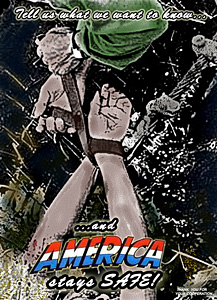Dear Judge Hellerstein: Ask About the OLC Torture Documents, Too
On Friday, Judge Alvin Hellerstein had a hearing to figure out how to end the contempt suit the ACLU brought against the CIA for destroying the torture tapes. The ACLU asked that he hold the CIA in contempt. Hellerstein said that wouldn’t serve much purpose. The ACLU suggested that he could hold individuals–presumably meaning Jose Rodriguez–in contempt. In the end, Hellerstein asked the two sides to brief him with suggestions. He seems likely, however, to do two things:
- Require the CIA to do a report for him to explain how they’ll prevent such a thing from happening in the future
- Meet with John Durham to hear what he learned in his investigation and make as much of that public as possible
Now, I’m all in favor of getting a very complete report very public report of how the CIA destroyed evidence of torture. The citizens of this country deserve–at the very least–an overview of the investigation and a clear explanation of the roles of the public figures like Porter Goss and John Rizzo. We deserve to know what John McPherson said about the earlier damage done to the torture tapes after John Durham immunized him–and whether Jose Rodriguez and George Tenet pressured him to lie about it. We deserve to know how this relates to all the lies CIA told Congress. We deserve to know each point when the White House got involved in this process.
But I bet you a quarter that Durham will say he can’t make any of this public, because of that mythic ongoing investigation into torture.
It’s what they do.
But as for the homework assignment Hellerstein plans on giving the CIA, to provide him with a report that will convince them they will prevent this kind of evidence disappearing in the future?
It has to go further than the torture tapes themselves.
As I cataloged last year, a great deal of evidence pertaining to torture disappeared over the years:
- Before May 2003: 15 of 92 torture tapes erased or damaged
- Early 2003: Gitmo commander Mike Dunlavey’s paper trail documenting the torture discussions surrounding Mohammed al-Qahtani “lost”
- Before August 2004: John Yoo and Patrick Philbin’s torture memo emails deleted
- June 2005: most copies of Philip Zelikow’s dissent to the May 2005 CAT memo destroyed
- November 8-9, 2005: 92 torture tapes destroyed
- July 2007 (probably): 10 documents from OLC SCIF disappear
- December 19, 2007: Fire breaks out in Cheney’s office
While we have no idea what, if anything, got destroyed in Cheney’s fire, we do know that CIA, DOD, DOJ, and the State Department (along with whoever owned the server on which John Yoo sent his most classified emails about torture) all somehow “lost” evidence pertaining to torture. It’s not just CIA’s problem, it’s the entire executive branch, seemingly losing torture evidence left and right.
And at the very least, Hellerstein ought to demand the very same kind of report from DOJ as he’s asking for from CIA. I mean, has DOJ done anything to make sure the drafts that go into our secret legal opinions authorizing the executive branch to ignore the law don’t disappear, as they did here?? Has DOJ done even the presumably minimal things CIA has done to make sure such documents don’t keep disappearing when they become inconvenient or dangerous? And what about John Yoo’s emails? What has DOJ done, Judge Hellerstein should ask, to find John Yoo’s missing emails and make sure similar emails don’t go missing in the future?
It’s not just the CIA that treated Judge Hellerstein’s order with contempt. So did DOJ. And yet our Justice Department is not even being held to the very low standard that our nation’s spooks are.

